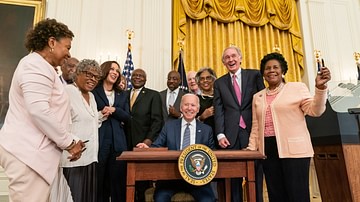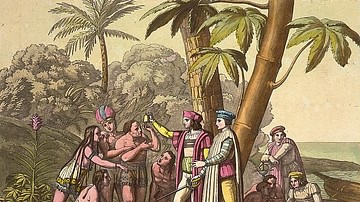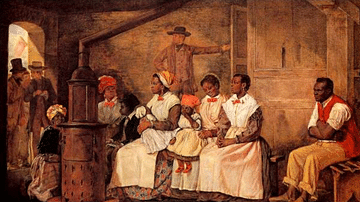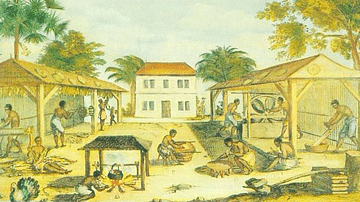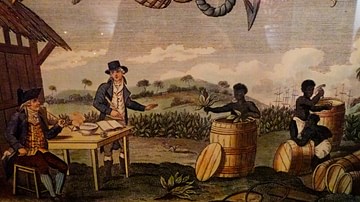Juneteenth is an annual event celebrating the end of chattel slavery in the United States in commemorating the issuance of General Order No. 3 (which included the line "all slaves are free") in Galveston, Texas on 19 June 1865. In 2021, Juneteenth was declared a federal holiday and is also celebrated outside of the United States.

Over the years, a number of myths concerning Juneteenth have developed which are repeated annually as part of the celebration's history. Among these is that General Order No. 3 ended slavery in the United States on 19 June 1865. Slavery was not abolished in the US until 6 December 1865 through the ratification of the 13th Amendment to the Constitution, and so General Order No. 3 did not end slavery, it only made clear that the Emancipation Proclamation of 1 January 1863, freeing slaves in the confederate states, would be enforced.
General Order No. 3 did not free slaves in the border states of Kentucky and Delaware or anywhere exempted by the Emancipation Proclamation. It did, however, proclaim freedom for the large slave population in Texas, and six months later, on 1 January 1866 (the three-year anniversary of the Emancipation Proclamation), the freed people of Texas celebrated the event as "Freedom Day", and 19 June 1866 became the first observance of what would become Juneteenth – a combination of "June" and "nineteenth."
From Texas, 19 June came to be celebrated annually in other states up through the early 20th century when observances declined, owing to social and political pressures, but were renewed even before the event became associated with the Civil Rights Movement of the 1950s and 1960s. Texas declared 19 June a state holiday in 1980, and other states, though not all, later followed suit until the Juneteenth National Independence Day Act was passed in June 2021, signed by President Joe Biden, making the event a federal holiday to be observed by all states.
Emancipation Proclamation & Texas
The American Civil War began on 12 April 1861, and by 1862, owing to the Union's blockade of Confederate ports, England was considering entering the conflict on the side of the Confederacy as regular imports, especially of cotton, had been interrupted indefinitely. Prior to this point, President Lincoln – no matter his personal feelings against slavery – did not believe he had a legal right to abolish the institution, nor was the war being fought as a crusade to end it. Scholar Edward T. Cotham Jr. comments:
Even if Lincoln had been persuaded that, as president, he had the legal authority to take some action to end slavery, in the early part of the Civil War he had every reason as a practical and political matter to deny that he ever intended to interfere with the institution. (13)
This was because, according to the Constitution, slavery was a state matter, and only individual states, not the federal government, could abolish it. In his now-famous open letter to the New York Tribune on 23 August 1862, Lincoln wrote:
My paramount object in this struggle is to save the Union and is not either to save or to destroy slavery. If I could save the Union without freeing any slave, I would do it, and if I could save it by freeing all the slaves, I would do it; and if I could save it by freeing some and leaving others alone, I would also do that. What I do about slavery, and the colored race, I do because I believe it helps to save the Union. (Norman-Cox, 32; Cotham, 15)
The war was not going well for the Union by 1862, and if England entered as an ally of the Confederacy, Lincoln feared all would be lost. He wanted to issue a proclamation freeing the slaves in the Confederate states as a strategic move to prevent England's intervention – since England, which had abolished slavery, could not legally support a cause fighting for its preservation – but wanted to do so from a position of strength. He needed a decisive victory, which only came with the Battle of Antietam on 17 September 1862. He issued the preliminary Emancipation Proclamation on 22 September 1862 stating that all slaves in those states currently in rebellion against the United States would be considered free on 1 January 1863.
Since the Confederate States regarded themselves as waging a war of independence against a tyrannical government – much like the original B colonies against Great Britain – they had no reason to pay any attention to the proclamation in September, nor when it was officially issued on 1 January 1863. The Emancipation Proclamation, in fact, did not free a single slave when issued and did not apply to the border states of Delaware, Kentucky, Maryland, or Missouri; it only applied to those states which did not recognize the authority of the government issuing it.
In order for the proclamation to have any real effect, it needed to be enforced by arms through Union victories over Confederate territories. As the Union army advanced, or as slaves were able to slip free from their masters and head toward Union lines, they were freed. As the Union began winning more battles in 1863, slave owners started moving slaves to Texas to keep them further from the Union advance so that, by 1865, over 200,000 slaves were being held there.
End of the War & 19 June
Although General Lee surrendered to General Grant on 9 April 1865 – the official end of the Civil War – the conflict was continued by other Confederate commanders who did not recognize Lee's surrender as applying to the Confederacy as a whole. The Trans-Mississippi Army of the Confederacy did not surrender until May (or early June) 1865, and parts of Texas were still in rebellion when Major General Gordon Granger's troops arrived in Galveston between 16-18 June 1865. Granger himself arrived on the 19th and issued General Order No. 3, enforcing the Emancipation Proclamation:
The people of Texas are informed that, in accordance with a proclamation from the Executive of the United States, all slaves are free. This involves an absolute equality of personal rights and rights of property between former masters and slaves, and the connection heretofore existing between them becomes that between employer and hired labor. The freedmen are advised to remain quietly at their present homes and work for wages. They are informed that they will not be allowed to collect at military posts and that they will not be supported in idleness either there or elsewhere. By order of G. Granger, Major General Commanding/F.W. Emory. Major & A.A. Gen'l. (Cotham, 199)
Contrary to the popular Juneteenth myth, there is no evidence that Granger called a public assembly and read General Order No. 3 and no evidence it was read from the balcony of the Ashton Villa. The order was handled by Granger's subordinate F. W. Emory (also given as Emery) who had it posted in newspapers and as handbills. Former masters were encouraged, and then required, to read the order to their slaves and inform them of their freedom.
Reactions
Immediate reaction to the news varied from celebration to confusion and, in many cases, nothing at all as masters refused to tell their slaves they were now free. Cotham relates a story told by the former slave John Bates on how he and his fellow slaves were told nothing about Granger's order, only hearing the rumor they were free from others passing along the road until they asked their master to confirm it, which he reluctantly did (204). Cotham relates how some others responded:
Despite the Juneteenth Order's admonition to the freed people to stay at their current location and continue to work for wages, many freed slaves promptly left their places of captivity to seek other opportunities. Molly Harrell, for example, recalled that most of the freed slaves around her wasted no time in getting on the road to the nearby town of Palestine. "We all walked down the road," she said, "singing and shouting to beat the band." Some former slaves found freedom confusing, as they were unfamiliar with any other way of life. Elsie Reece recalled the complete shock that accompanied her master's explanation that it was against the law for him to keep his workers on as slaves. (205)
The Union forces under Granger interviewed the former slaves and, if they could identify their former masters, they were sent back to his land to work as hired help. Those who could not or decided not to identify former masters and places of captivity were put to work cleaning the streets or on the Union's military ships in Galveston's harbor until the recently established Freedmen's Bureau could work out what to do with them. Fearing civil unrest after the issuance of General Order No. 3, Granger prohibited public gatherings, and freed people were not allowed to travel without written permission from their 'employers' or hold public celebrations.
Juneteenth Myths
A popular Juneteenth myth is that there were widespread celebrations throughout Texas on 19 June 1865. Newspaper articles, Granger's orders, and handbills of the time, cited by scholar D. J. Norman-Cox, make clear that, if there were any celebrations on that day, they were short-lived. The claim that General Order No. 3 freed all the slaves of Texas in a single day is also untenable as there was no public address system and no means of reaching every plantation, farm, and village with the news on 19 June. Emancipation across Texas was a slow process and, as noted, was hampered by slave owners refusing to comply with the order and, initially, no means of enforcing it in all areas of the state.
Another myth is that General Order No. 3 was read from the balcony, porch, or yard of the home known as Ashton Villa, owned by Confederate Colonel James Moreau Brown, which had served as the Confederate headquarters of Galveston during the war. Norman-Cox notes:
The most popular belief is that General Granger personally read his orders at what amounts to a town hall gathering in the front yard of someone's private residence, i.e., Ashton Villa. This theory has numerous flaws. It is implausible that townsfolk would have gathered at someone's private home without invitation or mandate, especially freedmen. Inarguably, commingling confederate men and women with freedmen was wholly inconsistent with race relations and social mores of 1865. Records of such grandstanding do not exist. The crowd being "generally Negroes" further decreases the probability they were invited to the home of one of Galveston's most prominent ex-confederates. (87)
This myth might have its origin in the Union's association with the home during the war. Ashton Villa had briefly served as the headquarters of the Union Army when they held Galveston in 1862, and so it may have seemed fitting that Granger would have delivered the news from there, a building formerly associated with both sides of the conflict. Documents make clear, however, that the order was issued from the Osterman Building, serving as the Union Headquarters District of Texas in June 1865.
Among the more persistent myths, regularly cited at Juneteenth celebrations, is that the enslaved people of Texas worked on for over two years without knowing they had been freed by the Emancipation Proclamation and only found this out when Granger arrived to deliver General Order No. 3. This claim is simply wrong. As noted, there was no way to enforce the Emancipation Proclamation in Confederate states, and slave owners did not consider the proclamation valid. Slaves who learned of the proclamation in 1862 and 1863 – as many did – only had the option of trying to reach Union lines. They were in no position to point out to their masters that President Lincoln had declared their freedom and they should be allowed to be on their way.

A central aspect of this myth is that it took until 19 June 1865 for the people of Texas to hear about the Emancipation Proclamation which had been issued on 22 September 1862 and 1 January 1863. This claim is untenable – as is the similar assertion that no one in Texas knew the war had ended until 19 June 1865. News traveled quite quickly via telegraph and the people of Texas knew of the proclamation in its earliest form in the fall of 1862. Texas was not somehow cut off from the channels of information that ran throughout the country. In 1836, when the Alamo in San Antonio fell to the Mexican army on 6 March, an article on it was already published in New Orleans by 28 March and another in the New York newspaper The Sun on 12 April. By 1865, owing to developments in the telegraph system during the war, news traveled even faster.
Conclusion
There are many other myths surrounding Juneteenth, as with any historical event, but these do not in any way diminish the significance of 19 June 1865 or the celebration that commemorates that day. Author Annette Gordon-Reed comments on the significance Juneteenth had for her family in Texas:
For my great-grandmother, my grandparents, and relatives in their generation, this was the celebration of the freedom of people they had actually known. My great-grandmother's mother had been married three times, outliving all of her husbands. Her last one had been enslaved until the end of the Civil War. Slavery was just a blink of an eye away from the years my grandparents and their friends were born. Although I was angered by the stories I heard about their lives under Jim Crow, and I had my own issues about the treatment of Blacks in my lifetime, they surely compared life as it was, knowing what it could have been but for the Civil War, the Emancipation Proclamation, and General Order No. 3. Although there was a very long way to go before we had full and equal citizenship, we were able to gather together as a family to celebrate. Family members who were lost, were lost to death, in the way that all families lose people. No one was being sold away. (135-136)
Juneteenth celebrations began in Texas in January 1866 under the name "Freedom Day" and then "Jubilee Day" referencing the Year of Jubilee from the Bible when, every seven years, slaves would be freed, but these were informal gatherings, not recognized by the state. 19 June 1865 was ruled as the date ending slavery in the state by the Texas Supreme Court in October 1868. This ruling was necessary because those who had purchased slaves or rented them from others and had not paid in full refused to pay any more as they no longer had use of those slaves.
The court ruled 19 June 1865 as the first day of emancipation in Texas to resolve this problem: those who had purchased or rented a slave before that date were required to pay what was owed while any agreement regarding slave sales or rentals after that date was legally voided. The court's ruling, officially recognizing 19 June 1865 as Emancipation Day in Texas, established that date for future celebrations.
The event began to be called Juneteenth beginning in the 1890s and first appears in print by that name in 1909. Although racially motivated policies and social pressures dampened observances throughout the first part of the 20th century, people continued to join together every year and, throughout the year, advocating for wider recognition of this celebration of freedom. Juneteenth was declared a federal holiday in the United States in 2021, but its significance had been recognized by many long before.


